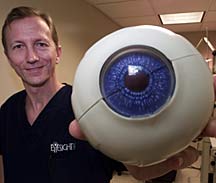Procedure can eliminate
corneal transplant
Isle doctor inserts two plastic rings
in the cornea to fix problems
![]()

Dr. John Olkowski says about 1 in 1,000 people, usually in their 20s to 40s, has Keratoconus.
Instead of corneal transplants for such patients, he has performed about 20 procedures in the past four years that involve implanting two little C-shaped plastic rings into the cornea.
Some patients with the Intacs Corneal Ring Inserts still may need corneal transplants but he hasn't had to do them on any of his patients with the rings, he said.
Olkowski reported the results of the inserts at a recent meeting of the American Academy of Ophthalmology in New Orleans.
He said in an interview that he began using the rings after a doctor in France reported having great results with them six years ago.
Other Hawaii ophthalmologists also are using the procedure now, he said. It has been approved by the U.S. Food and Drug Administration, ensuring health insurance coverage.
Olkowsky, associate medical director of the Hawaii Lion's Eye Bank, said about one in 1,000 people, usually in their 20s to 40s, have Keratoconus. It progresses, then stabilizes, he said.
The rings act to flatten the irregular-shaped cornea and add structural rigidity to it, making the cornea stronger rather than weaker, he said.
He said he also does laser treatment after implanting the rings to fine tune the patient's vision. "I'm one of only three or four in the world doing it. The results are fabulous."
www.eyesighthawaii.com/
American Academy of Ophthalmology
www.aao.org/
[News] [Business] [Features] [Sports] [Editorial] [Do It Electric!]
[Classified Ads] [Search] [Subscribe] [Info] [Letter to Editor]
[Feedback]
